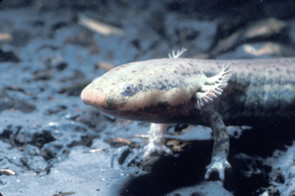
Siren intermedia
Photo by D Dennis
Description: The lesser siren is an eel-like aquatic salamander with a long slender body (18-68 cm long) and a very small dorsal fin that runs from the vent to the tail tip. The front legs are extremely reduced and the rear legs are completely absent; each foot has four toes. The head is rather flattened, and bushy external gills are located on each side of the head. The lesser siren varies in coloration from light grayish green to olive or black; there are also small irregular markings (dots) visible on lighter colored individuals. The designation "lesser" comes from the fact that most lesser sirens are less than 2 feet long (total length), in contrast to greater sirens (Siren lacertina), which are known to exceed 3 feet in length. For discriminating between the two species, authorities suggest counting costal grooves (external grooves along the sides of the animal between the forelimbs and the vent, which correspond roughly to the number of ribs).The greater siren usually has more than 36, whereas the lesser siren has less than 35 grooves. Sirens are generally regarded as the most primitive living salamanders.
Habitat/Range: Lesser sirens will inhabit most any slow moving and sluggish body of water that is shallow and has abundant aquatic vegetation including marshes, ponds, ditches, and canals. In most circumstances, they need a permanent or semi-permanent body of water but they are able to move short distances over land or stay encased in a cocoon of slime if drought occurs. Lesser sirens inhabit the Southeast from the Coastal Plain of Virginia south to southern Florida, west through central Georgia and Alabama through Louisiana, and north to western Tennessee and Kentucky.
Diet: The lesser siren feeds primarily on aquatic invertebrates such as crustaceans, insect larvae, worms, and snails. They will also readily consume young amphibian larvae and their own eggs. Lesser siren often feed by gulping large quantities of material at a time, which is filtered through the bronchial openings. Vegetable matter sometimes found in their digestive tracts is probably eaten accidentally.
Reproduction: The courtship behavior of lesser siren has not yet been described. Fertilization is presumed to be external, since the females lack cloacal sperm storage areas. Mating may be aggressive since both males and females show scaring from bite marks. Eggs are laid in early spring and are deposited in shallow depressions in the soft bottom of the occupied water body, usually in highly vegetated areas. In these shallow depressions the female will lay from 12 to over 300 eggs; the female may lay multiple clutches throughout the season. Freshly laid eggs are dark brown and 2.5-3 mm in diameter. The hatchling larvae are about 1.1 cm in length.

The shaded region represents the range of the lesser siren in North Carolina.
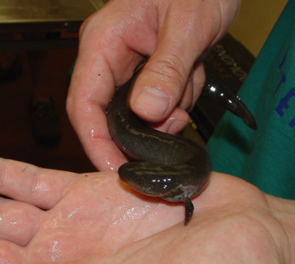
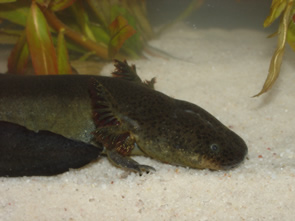
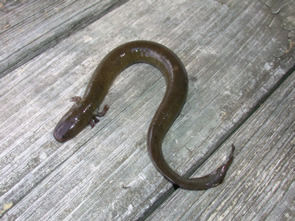
Photo by D Stevenson
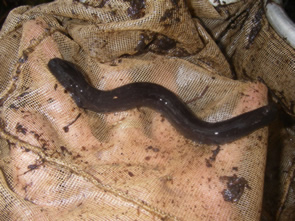
Photo by Kristen Cecala
